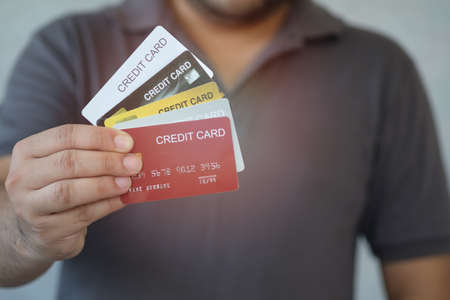1. Understanding Your Credit Card Debt
Before you can create a plan to pay off your credit card debt quickly, its important to understand exactly what you owe. This means assessing your total balance, interest rates, and minimum payments. Knowing these details will help you prioritize which debts to tackle first.
(1) Assess Your Total Debt
Start by listing all your credit cards along with their outstanding balances. This will give you a clear picture of how much you owe in total.
| Credit Card | Outstanding Balance | Interest Rate (APR) | Minimum Payment |
|---|---|---|---|
| Card A | $5,000 | 18% | $150 |
| Card B | $3,000 | 22% | $90 |
| Card C | $1,500 | 15% | $45 |
(2) Identify Interest Rates and Their Impact
The higher the interest rate, the more money youre paying over time. Focus on the cards with the highest APRs first, as they cost you the most in interest charges.
(3) Review Minimum Payments
Your minimum payment is the smallest amount you must pay each month to avoid late fees. However, just paying the minimum can keep you in debt for years. Understanding your minimum payment requirements helps in planning an effective repayment strategy.
2. Creating a Budget and Cutting Expenses
One of the most effective ways to pay off credit card debt faster is to create a budget and find areas where you can cut expenses. A well-planned budget helps you track your income and spending, ensuring that you allocate more money toward paying down your debt.
How to Create a Budget
Start by listing all your sources of income and then categorize your monthly expenses. This will give you a clear picture of where your money is going.
| Category | Example Expenses |
|---|---|
| Fixed Expenses | Rent/Mortgage, Insurance, Loan Payments |
| Variable Expenses | Groceries, Utilities, Transportation |
| Discretionary Spending | Dining Out, Entertainment, Subscriptions |
Identifying Areas to Cut Back
If youre serious about paying off your credit card debt quickly, youll need to find ways to reduce unnecessary spending. Here are some practical steps:
(1) Reduce Dining Out and Takeout
Instead of eating out frequently, try cooking meals at home. Meal prepping can save both time and money.
(2) Cancel Unused Subscriptions
Review your subscriptions (streaming services, gym memberships, apps) and cancel the ones you rarely use.
(3) Shop Smart for Groceries
Create a shopping list before heading to the store and stick to it. Look for discounts, coupons, and bulk deals.
(4) Cut Back on Entertainment Costs
Consider free or low-cost entertainment options like community events, library rentals, or outdoor activities.
(5) Lower Utility Bills
You can save on utilities by turning off unused lights, unplugging electronics, and using energy-efficient appliances.
Reallocating Savings Toward Debt Repayment
The money saved from cutting expenses should be redirected toward paying down your credit card debt. Consider making extra payments toward your highest-interest debt first or using the snowball method to gain momentum in your repayment journey.
![]()
3. Choosing a Repayment Strategy
Paying off credit card debt efficiently requires a solid strategy. Two of the most popular methods are the snowball and avalanche strategies. Each has its advantages, and choosing the right one depends on your financial situation and personal preferences.
Snowball Method
The snowball method focuses on paying off the smallest debt first while making minimum payments on all other balances. Once the smallest debt is cleared, you move to the next smallest, creating momentum as you go.
Steps to Follow:
- List all your credit card debts from smallest to largest.
- Make minimum payments on all cards except the smallest one.
- Put any extra money toward paying off the smallest debt.
- Once its paid off, roll that payment amount into the next smallest debt.
- Repeat until all debts are cleared.
Pros and Cons of the Snowball Method
| Pros | Cons |
|---|---|
| Provides quick wins for motivation | Might pay more interest over time |
| Helps build positive financial habits | Doesnt prioritize high-interest debt first |
Avalanche Method
The avalanche method prioritizes paying off debts with the highest interest rate first, minimizing overall interest payments in the long run.
Steps to Follow:
- List your debts from highest to lowest interest rate.
- Make minimum payments on all debts except the one with the highest interest rate.
- Put any extra funds toward paying off the highest-interest debt.
- Once its paid off, focus on the next highest interest debt.
- Continue until all debts are eliminated.
Pros and Cons of the Avalanche Method
| Pros | Cons |
|---|---|
| Saves money on interest over time | Might take longer to see progress |
| Pays off high-cost debt faster | Requires strong discipline to stay motivated |
Which Strategy Should You Choose?
The best strategy depends on your financial goals and mindset. If you need quick motivation, the snowball method may work best. If youre focused on saving money in the long run, the avalanche method is a better fit. No matter which approach you choose, staying consistent is key to becoming debt-free faster.
4. Considering Balance Transfers or Debt Consolidation
High-interest rates can make it difficult to pay off credit card debt quickly. If you’re struggling with multiple cards and high interest, exploring balance transfers or debt consolidation could help lower your interest rate and simplify payments.
Understanding Balance Transfers
A balance transfer involves moving your existing credit card debt to a new card with a lower or 0% introductory APR for a set period. This allows you to focus on paying off the principal without accumulating additional interest.
(1) Benefits of a Balance Transfer
- Lower or 0% introductory interest rate
- Potential savings on interest payments
- Simplified repayment with fewer accounts to manage
(2) Things to Consider
- Balance transfer fees (typically 3%-5% of the transferred amount)
- The length of the promotional APR period
- The regular APR after the promotional period ends
- The risk of accumulating new debt on old cards
Debt Consolidation Loans
If you have multiple credit cards with high balances, a debt consolidation loan can help streamline payments by combining all debts into one fixed monthly payment, usually at a lower interest rate.
(1) Advantages of Debt Consolidation Loans
- Potentially lower interest rates compared to credit cards
- Fixed repayment terms for better budgeting
- A single monthly payment instead of managing multiple accounts
(2) What to Watch Out For
- Origination fees that add to the loan cost
- The need for good credit to qualify for low rates
- The risk of extending repayment time and paying more in total interest
- Avoiding new credit card debt after consolidation
Comparing Your Options
| Option | Main Benefit | Main Risk | Best For |
|---|---|---|---|
| Balance Transfer Credit Card | 0% intro APR for a limited time, saving on interest | Balance transfer fees; higher APR after promo ends | If you can pay off the balance before the promo expires |
| Debt Consolidation Loan | Simplifies payments with a lower fixed interest rate | Might extend repayment term and increase total interest paid | If you have multiple high-interest credit card balances and need structured repayment |
Is This the Right Move for You?
If youre committed to getting out of credit card debt, balance transfers or debt consolidation can be effective tools. However, it’s essential to compare offers, understand the costs involved, and ensure you won’t rack up new credit card debt while paying off your existing balance.
5. Building Better Financial Habits
Paying off credit card debt is an important step, but building strong financial habits will help you stay out of debt in the long run. By making small changes to your spending and saving habits, you can avoid falling back into the cycle of credit card debt.
Avoid Unnecessary Credit Card Use
One of the best ways to prevent future debt is to be mindful of how you use your credit card. Consider these strategies:
- Use cash or a debit card for everyday expenses.
- Only charge what you can pay off in full each month.
- Set a personal limit for credit card spending.
- Turn off saved payment methods on shopping websites to reduce impulse purchases.
Prioritize Savings
Having savings can prevent you from relying on credit cards during emergencies. Here are some ways to build your savings:
| Strategy | Description |
|---|---|
| Emergency Fund | Save at least 3-6 months worth of expenses to cover unexpected costs. |
| Automated Savings | Set up automatic transfers to your savings account each payday. |
| Cut Unnecessary Expenses | Review your monthly budget and eliminate non-essential spending. |
| Side Income | Consider a part-time job or freelance work to boost your savings faster. |
Create and Stick to a Budget
A well-planned budget helps you manage expenses and avoid overspending. Follow these steps:
(1) Track Your Spending
Monitor where your money goes each month and identify areas where you can cut back.
(2) Set Spending Limits
Allocate specific amounts for different categories like groceries, entertainment, and dining out.
(3) Plan for Irregular Expenses
Account for occasional costs like car repairs, medical bills, or holiday shopping by setting aside money in advance.
(1) Review Your Budget Regularly
Your financial situation may change over time, so adjust your budget as needed to stay on track.
(2) Stay Accountable
Use budgeting apps or enlist a friend or family member to help keep you accountable for your spending goals.
Use Credit Cards Responsibly
If you continue using credit cards, follow these responsible habits:
- Pay your balance in full every month to avoid interest charges.
- Avoid opening multiple new credit accounts unless necessary.
- Use rewards and cashback programs wisely—only if they align with your budget and financial goals.
- Regularly check your credit report to ensure accuracy and maintain good credit health.
By developing these better financial habits, you can break free from the cycle of credit card debt and achieve long-term financial stability.


